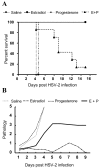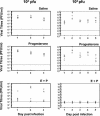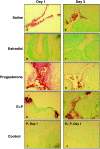Estradiol regulates susceptibility following primary exposure to genital herpes simplex virus type 2, while progesterone induces inflammation
- PMID: 15709030
- PMCID: PMC548484
- DOI: 10.1128/JVI.79.5.3107-3116.2005
Estradiol regulates susceptibility following primary exposure to genital herpes simplex virus type 2, while progesterone induces inflammation
Abstract
We report here that sex hormones modulate susceptibility to a sexually transmitted viral agent, herpes simplex virus type 2 (HSV-2), in a mouse model. Ovariectomized mice were administered either saline (control), estradiol (E(2)), progesterone (P(4)), or a combination of both estradiol and progesterone (E+P) and infected intravaginally with HSV-2. With an inoculation dose of 10(5) PFU, the saline- and P(4)-treated mice were found to be highly susceptible to genital HSV-2 infection. Both groups had extensive pathology and high viral titers in vaginal secretions, and 100% of mice succumbed by day 4 postinfection. E(2)-treated mice were protected from HSV-2 infection at the same dose and did not display any vaginal pathology or viral shedding. There was a slow progression of genital pathology in the combination hormone-treated group, along with prolonged viral shedding; 80% of animals succumbed by day 13. With lower inoculation doses of 10(3) and 10(2) PFU, 50 and 100%, respectively, of the combination hormone-treated mice survived. Localization of HSV-2 infection showed extensive infection in the vaginal epithelium of P(4)- and saline-treated animals within 24 h of inoculation. E(2)-treated animals were clear of infection, while the E+P-treated group had focal infection at 24 h that had progressed extensively by day 3. Infection was accompanied by persistent inflammation and infiltration of neutrophils in the P(4)-treated group. An analysis of the genes in the vaginal tissue showed that inflammation in the P(4)-treated group correlated with local induction of chemokines and chemokine receptors that were absent in the E(2)-treated mice and in uninfected P(4)-treated mice. The results show that sex hormones regulate initiation of infection and immune responses to genital HSV-2 infection.
Figures







Similar articles
-
Protection against genital herpes infection in mice immunized under different hormonal conditions correlates with induction of vagina-associated lymphoid tissue.J Virol. 2005 Mar;79(5):3117-26. doi: 10.1128/JVI.79.5.3117-3126.2005. J Virol. 2005. PMID: 15709031 Free PMC article.
-
A mouse model for studies of mucosal immunity to vaginal infection by herpes simplex virus type 2.Lab Invest. 1994 Mar;70(3):369-80. Lab Invest. 1994. PMID: 8145530
-
Intranasal and subcutaneous immunization under the effect of estradiol leads to better protection against genital HSV-2 challenge compared to progesterone.Vaccine. 2008 Nov 11;26(48):6165-72. doi: 10.1016/j.vaccine.2008.08.045. Epub 2008 Sep 18. Vaccine. 2008. PMID: 18804503
-
Protective immunity against HSV-2 in the mouse vagina.J Reprod Immunol. 1997 Nov 30;36(1-2):77-92. doi: 10.1016/s0165-0378(97)00055-7. J Reprod Immunol. 1997. PMID: 9430740 Review.
-
Regulation of innate and adaptive immunity by the female sex hormones oestradiol and progesterone.FEMS Immunol Med Microbiol. 2003 Aug 18;38(1):13-22. doi: 10.1016/S0928-8244(03)00202-5. FEMS Immunol Med Microbiol. 2003. PMID: 12900050 Review.
Cited by
-
Locally administered nanosuspension increases delivery of estradiol for the treatment of vaginal atrophy in mice.Drug Deliv Transl Res. 2024 May 15. doi: 10.1007/s13346-024-01618-6. Online ahead of print. Drug Deliv Transl Res. 2024. PMID: 38748201
-
Ovarian sex steroid and epithelial control of immune responses in the uterus and oviduct: human and animal models†.Biol Reprod. 2024 Feb 10;110(2):230-245. doi: 10.1093/biolre/ioad166. Biol Reprod. 2024. PMID: 38038990 Free PMC article.
-
Superior antiviral activity of IFNβ in genital HSV-1 infection.Front Cell Infect Microbiol. 2022 Oct 17;12:949036. doi: 10.3389/fcimb.2022.949036. eCollection 2022. Front Cell Infect Microbiol. 2022. PMID: 36325470 Free PMC article.
-
Zika Virus Replicates in the Vagina of Mice with Intact Interferon Signaling.J Virol. 2022 Sep 28;96(18):e0121922. doi: 10.1128/jvi.01219-22. Epub 2022 Aug 30. J Virol. 2022. PMID: 36040178 Free PMC article.
-
Primary HSV-2 Infection in Early Pregnancy Results in Transplacental Viral Transmission and Dose-Dependent Adverse Pregnancy Outcomes in a Novel Mouse Model.Viruses. 2021 Sep 25;13(10):1929. doi: 10.3390/v13101929. Viruses. 2021. PMID: 34696359 Free PMC article.
References
-
- Bernstein, D. I. 2001. Potential for immunotherapy in the treatment of herpesvirus infections. Herpes 8:8-11. - PubMed
-
- Crowley, T., P. Horner, A. Hughes, J. Berry, I. Paul, and O. Caul. 1997. Hormonal factors and laboratory detection of Chlamydia trachomatis in women: implications for screening? Int. J. STD AIDS 8:25-31. - PubMed
-
- Cunningham, A. L., and Z. Mikloska. 2001. The holy grail: immune control of human herpes simplex virus infection and disease. Herpes 8(Suppl. 1):6A-10A. - PubMed
-
- Gallichan, W. S., and K. L. Rosenthal. 1996. Effects of the estrous cycle on local humoral immune responses and protection of intranasally immunized female mice against herpes simplex virus type 2 infection in the genital tract. Virology 224:487-497. - PubMed
Publication types
MeSH terms
Substances
LinkOut - more resources
Full Text Sources
Other Literature Sources
Medical

